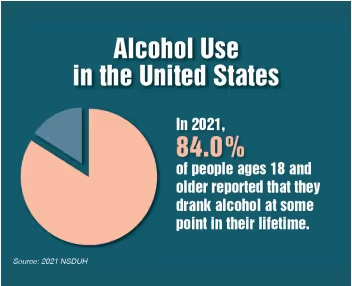Alcoholism Statistics & Alcohol Abuse Demographics


Looking For Alcoholism Statistics?
Alcohol abuse is a serious problem that affects millions of people globally. In this roundup of alcohol abuse and alcoholism statistics, we will examine the latest alcohol abuse statistics as of 2023.
Key Alcoholism & Alcohol Abuse Statistics:
- According to the World Health Organization (WHO), alcohol consumption is responsible for 3 million deaths worldwide each year.
- In the United States, alcohol abuse costs the economy approximately $250 billion annually, according to the National Institute on Alcohol Abuse and Alcoholism (NIAAA).
- The NIAAA also reports that 14.5 million adults (aged 18 and older) in the United States have Alcohol Use Disorder (AUD).
- In Europe, alcohol consumption is responsible for approximately 7% of all deaths, according to the European Observatory on Health Systems and Policies.
- In Australia, alcohol-related harm costs the economy approximately $15 billion each year, according to the Foundation for Alcohol Research and Education (FARE).
- The FARE also reports that 5,500 deaths each year in Australia are attributable to alcohol.
These statistics highlight the significant impact that alcohol abuse has on individuals and society as a whole. It's important to note that alcohol abuse can lead to a wide range of negative consequences, including liver disease, cancer, mental health issues, and social problems.
How Many People Abuse Alcohol?
Approximately 85.6% of people aged 18 or older reported that they drank alcohol at some point in their lifetime (National Survey on Drug Use and Health, 2020).
69.5% of people aged 18 or older reported that they drank alcohol in the past year (National Survey on Drug Use and Health, 2020).
Of those who reported drinking in the past year:
- About 25.8% reported binge drinking (consuming five or more drinks on one occasion) at least once in the past month (National Survey on Drug Use and Health, 2020).
- 6.3% reported heavy alcohol use (binge drinking on five or more days in the past month) (National Survey on Drug Use and Health, 2020).
It's important to note that while not everyone who drinks will develop AUD, these statistics show that a significant portion of the population engages in risky drinking behaviors that can lead to negative consequences for both themselves and others around them.
Alcohol Use in the United States: Age Groups and Demographic Characteristics
Alcohol consumption is prevalent across all age groups in the United States, with some variations in drinking patterns among different demographic groups. The National Survey on Drug Use and Health (NSDUH) provides data on alcohol use by age and various demographic characteristics.
Alcohol Abuse Prevalence By Age:
- Among people aged 18 to 25, 55.3% reported drinking alcohol in the past month, while 34.2% reported binge drinking at least once during that time.
- For those aged 26 or older, 54.1% reported drinking alcohol in the past month, while 14.7% reported binge drinking at least once during that time.
- People aged 12 to 17 were less likely to report alcohol use, with only 9.4% reporting past-month alcohol use and just over 2% reporting binge drinking.

Alcohol Abuse Prevalence By Gender:
Alcohol abuse affects both men and women, but research has shown that there are some gender differences in drinking patterns. According to the National Institute on Alcohol Abuse and Alcoholism (NIAAA), men are more likely than women to engage in binge drinking and heavy alcohol use.
In contrast, women are more likely than men to experience negative health consequences from alcohol use, such as liver disease and breast cancer.
The NIAAA reports that in the United States:
- In 2020, 62.6% of adult men reported drinking alcohol in the past month, compared to 49.3% of adult women.
- Men were also more likely than women to report binge drinking at least once in the past month (28.5% vs. 13.7%) and heavy alcohol use (9.5% vs. 3.3%).
These statistics show that while both men and women drink alcohol, men tend to engage in riskier drinking behaviors that can lead to negative consequences for their health and well-being.
Alcohol Abuse Prevalence By Race:
Alcohol abuse affects people of all races and ethnicities in the United States, but research has shown that there are some differences in drinking patterns among different racial groups. According to the National Survey on Drug Use and Health (NSDUH), American Indians/Alaska Natives have the highest rates of heavy alcohol use, followed by whites, Hispanics, blacks, and Asians.
In 2020, among adults aged 18 or older who reported drinking alcohol in the past month:
- 62.8% of whites reported drinking alcohol
- 54.9% of Hispanics reported drinking alcohol
- 52.1% of blacks reported drinking alcohol
- 47.5% of Asians reported drinking alcohol
In terms of binge drinking (consuming five or more drinks on one occasion), the rates were as follows:
- 26.7% for whites
- 21.6% for Hispanics
- 18.3% for blacks
- 12.4% for Asians
These statistics suggest that while alcohol consumption is prevalent across all racial groups in the United States, there are some differences in drinking patterns and behaviors that can lead to negative consequences for health and well-being.
These statistics show that age and demographic characteristics can influence an individual's likelihood of engaging in risky drinking behaviors such as binge drinking or heavy alcohol use. It's important for public health initiatives to take these variations into account when developing prevention strategies aimed at reducing harmful levels of alcohol consumption across all populations.
Binge Drinking Statistics
Binge drinking is a serious concern as it can lead to many health problems and even death.
According to the National Survey on Drug Use and Health (NSDUH), about 25.8% of people who reported drinking in the past year engaged in binge drinking at least once in the past month. This translates to approximately 66 million people aged 18 or older in the United States alone.
Binge drinking statistics also vary by state:
- Wisconsin has the highest percentage of adults who report binge drinking, with over 24% of adults engaging in this behavior (Centers for Disease Control and Prevention).
- Utah has the lowest percentage, with only 10% of adults reporting binge drinking (Centers for Disease Control and Prevention).
It's important to note that binge drinking can have serious consequences beyond just short-term impairment. It can lead to alcohol poisoning, liver disease, and increased risk of accidents and injuries.
Public health initiatives should focus on reducing rates of binge drinking through education and awareness campaigns that emphasize responsible alcohol use and moderation.

How Much Alcohol Are People Drinking?
How much alcohol people consume is an important factor in assessing the prevalence and severity of alcohol abuse.
According to the National Survey on Drug Use and Health (NSDUH), approximately 85.6% of people aged 18 or older reported that they drank alcohol at some point in their lifetime. Among those who reported drinking in the past year, about 69.5% reported consuming alcohol within the last month.
The NSDUH also found that among those who drank in the past month:
- The majority (56%) consumed beer, followed by wine (19%), and liquor (24%).
- The average number of drinks consumed per occasion was 4.
- The average number of drinking days per month was 8.
These statistics provide insight into how much alcohol people are consuming and what types of beverages they prefer. It's important to note that while moderate alcohol consumption may have some health benefits, excessive alcohol consumption can lead to serious negative consequences for both physical and mental health.
Public health initiatives should continue to focus on reducing rates of harmful levels of alcohol consumption through education, awareness campaigns, and policy changes aimed at promoting responsible drinking habits.
What Is The Most Consumed Alcohol In The World?
According to the World Health Organization (WHO), beer is the most consumed alcoholic beverage in the world.
- Beer, accounts for approximately 50% of all alcohol consumed globally.
- Wine, which makes up around 14% of global alcohol consumption
- Spirits such as whiskey and vodka, which account for about 12%.
However, it's important to note that these figures can vary significantly by region and cultural traditions.
For example, in some countries such as Russia and Poland, vodka is a more popular choice than beer or wine.
Understanding what types of alcoholic beverages are most commonly consumed can help policymakers develop more effective strategies for reducing harmful levels of alcohol consumption and promoting responsible drinking habits.
How Many People Die From Alcohol-Related Causes?
Alcohol-related deaths are a significant concern worldwide.
According to the World Health Organization (WHO), alcohol consumption is responsible for approximately 3 million deaths each year globally.
In the United States, alcohol-related causes account for an average of 88,000 deaths each year, according to the National Institute on Alcohol Abuse and Alcoholism (NIAAA).
This number includes deaths from:
- Liver disease
- Cancer
- Car accidents
- Other health issues related to excessive alcohol consumption.
It's important to note that while not all individuals who drink heavily will die from alcohol-related causes, these statistics highlight the serious health risks associated with long-term heavy drinking.
Taking steps to reduce harmful levels of alcohol consumption can help prevent premature death and improve overall health outcomes. Public health initiatives should continue to focus on raising awareness about the risks associated with excessive alcohol consumption and promoting responsible drinking habits.
Alcoholism Treatment Statistics
Alcohol use disorder (AUD) is a chronic condition that can be difficult to overcome without proper treatment. However, many people who struggle with AUD do not receive the help they need.
According to the National Survey on Drug Use and Health (NSDUH):
- Only about 6.7% of adults who needed alcoholism treatment in the past year actually received it.
- Among those who did receive treatment, the majority (67.7%) received it in an outpatient setting, while 16.9% received inpatient treatment.
These statistics suggest that there is a significant gap between the number of people who need alcoholism treatment and those who actually receive it. This underscores the importance of increasing access to evidence-based treatments for AUD, such as behavioral therapies and medications.
Research has shown that seeking professional help for AUD can significantly improve outcomes. For example, one study found that individuals who participated in cognitive-behavioral therapy had higher rates of abstinence from alcohol compared to those who did not receive this type of treatment.
It's important for public health initiatives to focus on increasing awareness about available resources for AUD treatment and reducing barriers to accessing these resources, such as cost or stigma associated with seeking help for addiction. By doing so, we can improve outcomes for individuals struggling with AUD and reduce the negative impact that alcohol abuse has on society as a whole.
FAQs
Q: What is considered "moderate" drinking?
A: Moderate drinking is defined as up to one drink per day for women and up to two drinks per day for men. It's important to note that these guidelines are not a recommendation to drink, but rather a guideline for those who already choose to consume alcohol.
Q: Is it possible to develop alcohol use disorder (AUD) after only a few episodes of binge drinking?
A: Yes, it is possible. Binge drinking can lead to changes in the brain that increase the likelihood of developing AUD. Additionally, repeated episodes of binge drinking can quickly escalate into chronic heavy drinking.
Q: Can alcohol abuse cause mental health issues?
A: Yes, chronic heavy drinking can lead to or exacerbate mental health issues such as anxiety and depression. It can also lead to cognitive impairment and memory problems.
Q: Can alcohol abuse cause physical health problems?
A: Yes, excessive alcohol consumption can lead to a range of physical health problems such as liver disease, high blood pressure, and increased risk of cancer.
Q: How can I tell if someone has an alcohol problem?
A: Signs of an alcohol problem may include:
- Drinking alone or in secret
- Drinking more than intended or being unable to stop once started
- Neglecting responsibilities at home or work due to drinking
- Continuing to drink despite negative consequences such as legal trouble or relationship problems
- Experiencing withdrawal symptoms when attempting to quit or cut back on drinking
If you think someone you know may have an alcohol problem, it's important to approach the topic with care and compassion and encourage them to seek professional help.
Q: Is it possible to recover from alcoholism?
A: Yes, recovery from alcoholism is possible with proper treatment and support. Treatment options may include behavioral therapies such as cognitive-behavioral therapy and medications such as naltrexone or acamprosate. It's important to note that recovery is a lifelong process and requires ongoing effort and commitment.
Conclusion
Alcohol consumption is a widespread phenomenon with significant implications for public health and society as a whole.
The alcohol abuse statistics presented in this article demonstrate the need for targeted interventions to reduce harmful levels of alcohol consumption and promote responsible drinking habits across all populations. From binge drinking to alcoholism, the negative consequences of excessive alcohol use are vast and far-reaching.
However, recovery from alcoholism is possible with proper treatment and support. It is essential that we continue to raise awareness about the risks associated with excessive alcohol consumption and increase access to evidence-based treatments for those struggling with AUD.
By doing so, we can improve outcomes for individuals and communities affected by alcohol abuse and work towards a healthier, safer future for all.
